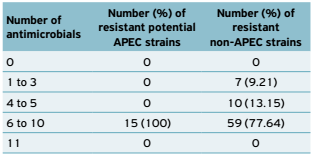ABSTRACT:
Avian pathogenic Escherichia coli (APEC) strains are isolated from lesions of poultry presenting colibacillosis, which is a disease that causes either systemic or localized clinical signs. Such strains share many characteristics with E. coli strains that cause extra-intestinal illness in humans. There is not a consensus on how to define the APEC pathotype with regard to the presence of virulence traits. On the other hand, in the past few years, five minimal predictors for APEC detection were proposed. The E. coli isolates in this work were tested through polymerase chain reaction (PCR) to the five proposed minimal predictors and cva C. The strains presenting them were categorized as potential APEC. The APEC and non-APEC categories showed high resistance (> 50%) to cephalotin, erythromycin, streptomycin, sulphametoxazol/trimethoprim, ampicillin, and amoxicillin. Potential APEC strains were significantly more resistant to cephalotin (p < 0.05) and neomcycin (p < 0.01) than non-APEC. These latter were significantly more resistant to tetracycline (p < 0.01) than the potential APEC strains. These results demonstrate that feces of poultry present E. coli strains with resistant features, showing or not the potential of causing colibacillosis in poultry. Because APEC and extra-intestinal illness in humans may be similar, these resistant strains are of interest to public health.
KEYWORDS:
Escherichia coli; avian pathogenic Escherichia coli; antimicrobial resistance, broiler chickens


